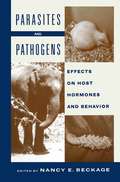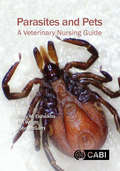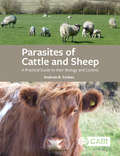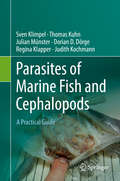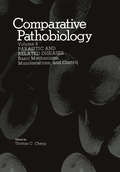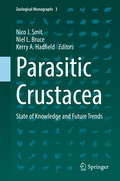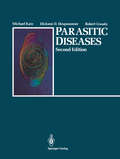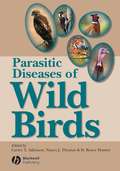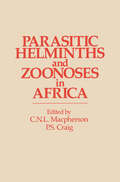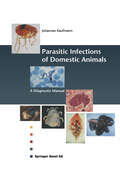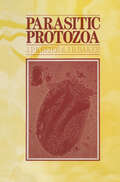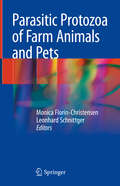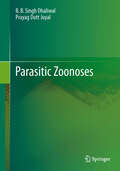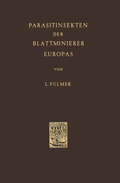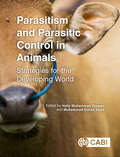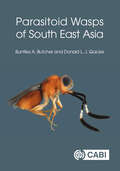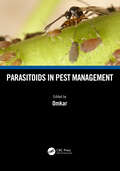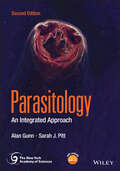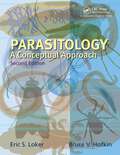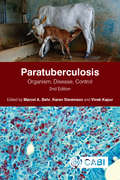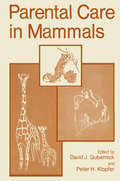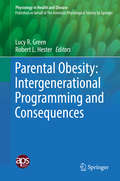- Table View
- List View
Parasites and Pathogens: Effects On Host Hormones and Behavior
by N.E. BeckageWhen Nancy Beckage and I first met in Lynn Riddiford's laboratory at the University of Washington in the mid 1970s, the fields of parasitology, behavior, and endocrinology were thriving and far-flung--disciplines in no serious danger of intersecting. There were rumors that they might have some common ground: Behavioural Aspects of Parasite Transmission (Canning and Wright, 1972) had just emerged, with exciting news not only of the way parasites themselves behave, but also of Machiavellian worms that caused intermediate hosts to shift fundamental responses to light and disturbance, becoming in the process more vulnerable to predation by the next host (Holmes and Bethel, 1972). Meanwhile, biologists such as Miriam Rothschild (see Dedication), G. B. Solomon (1969), and Lynn Riddiford herself (1975) had suggested that the endocrinological rami of parasitism might be subtle and pervasive. In general, however, para fications sites were viewed as aberrant organisms, perhaps good for a few just-so stories prior to turning our attention once again to real animals. In the decade that followed, Pauline Lawrence (1986a,b), Davy Jones (Jones et al. , 1986), Nancy Beckage (Beckage, 1985; Beckage and Templeton, 1986), and others, including many in this volume, left no doubt that the host-parasite combination in insect systems was physiologically distinct from its unparasitized counterpart in ways that went beyond gross pathology.
Parasites and Pets: A Veterinary Nursing Guide
by Hany Elsheikha Dr Ian Wright John McGarryThis book, primarily focussing on parasitic diseases of cats and dogs, is designed specifically for veterinary nurses and students and adopts an enquiry based approach essential for consolidating knowledge and a deep practical understanding of this important subject. The book goes beyond the conventional discourse of parasitology books, with each chapter addressing questions commonly posed by clients. It is illustrated throughout with colour figures and readers can assess their knowledge and areas for development by completing the end of chapter self-assessment questions. In this way, the veterinary nurse will be fully equipped to professionally support veterinary surgeons in achieving optimal strategies for management of parasitic diseases of companion animals. Provides a unique enquiry-based approach to assist veterinary nurses and technicians in gaining essential knowledge and practical understanding of parasites Contains self-assessment MCQ sections designed to encourage the reader to question their practice, rationales, and the evidence base of parasitology care delivery they provide to patients Focuses on the dog and cat, the most commonly seen pets
Parasites of Cattle and Sheep: A Practical Guide to their Biology and Control
by Andrew B ForbesUnderstanding parasite biology and impact is essential when giving advice on parasite control in farm animals. In the first review devoted to parasites of domestic cattle and sheep alone, this book provides in-depth, focused advice which can be tailored to individual farms. It considers the impact of parasites, both as individual species and as co-infections, as well as epidemiological information, monitoring, and diagnostic procedures. Supported throughout by diagrams and photos to aid diagnosis, it also reviews the basis for control measures such as the responsible use of parasiticides, adaptive animal husbandry and other management practices. This book: Focuses on common parasites of domestic sheep and cattle; Places emphasis on understanding host responses and epidemiology so that the impact and seasonality of parasitism can be incorporated into advice and decision making; Highlights the fundamental importance of the individual farm and farmer in assessing endemic parasitism and tailoring control options accordingly; Provides a comprehensive reference listing, including important historical citations, to underpin the content. An important resource for students, veterinarians and researchers of farm animal health, this book maintains a focus on ruminant parasitology in order to deliver evidence-based advice and also context for the application of basic research.
Parasites of Marine Fish and Cephalopods: A Practical Guide
by Sven Klimpel Thomas Kuhn Julian Münster Dorian D. Dörge Regina Klapper Judith KochmannThis textbook provides a comprehensive, reliable and practical guide to the dissection and parasitological examination of marine fish and cephalopods. The first part provides a general introduction, presenting basic information on: parasitology, ecology of the marine environment, history and methods of fisheries and aquaculture, as well as the ecology of marine fish and cephalopods and the impact of parasites on hosts. In turn, the second part provides general information on the morphology and anatomy of marine fish and cephalopods using the example of abundant morphotypes (including e.g. habitus photos of the body cavity and internal organs). The third part covers the relevant parasitic groups, their ecology (e.g. lifecycles, transmission), related diseases, and detection. The fourth part, a comprehensive methods section, provides essential protocols and applications of common dissection methods (for roundfish, flatfish and cephalopods) and stomach content analyses, as well as parasite preservation, preparation and molecular identification. Basic calculations of the most common infection and ecological parameters are also introduced. The book’s fifth and final part provides information on health risks associated with fish and cephalopod consumption, as well as the prevention of human infection through the correct handling and processing of fish samples. The appendix provides e.g. blank sheets for recording fish dissections and parasitological examinations.
Parasitic and Related Diseases: Basic Mechanisms, Manifestations, and Control (Comparative Pathobiology #8)
by Thomas C. ChengThe study of parasites and their interactions with hosts continues to represent a challenging area of modern biology. The availability of new techniques and instrumentation, coupled with the development of daring new hypotheses and concepts, has paved the way for the dramatic evolution of parasitology from a static descriptive endeavor to a dynamic one based on biochemistry, immunology, molecular biology, and modern cell biology. Studies of this nature obviously fall within the domain of pathobiology. Consequently, when the contributions included in this volume of Comparative PathobioZogy were offered to this series. after critical review, we welcomed the opportunity to make them available to the scientific community. The contributions included herein represent presentations delivered before enthusiastic audiences at three different symposia, all held in 1983. The first, entitled "Some Aspects of Modern Parasitology", was organized by Dr. Gary E. Rodrick of the University of South Florida and myself on behalf of the American Society of Zoologists. The chapters by C. E. Carter and B. M. Wickwire. B. J. Bogitsh, and W. M. Kemp were originally presented at that symposium. The second symposium. organized by Dr. G. Balouet of the Faculte de Medecine, Brest, France, and myself on behalf,of the Society for Invertebrate Pathology, was entitled "Cellular Reactions in Invertebrates." The chapters by G. Balouet and M. Poder and M. Brehelin were originally presented at this symposium.
Parasitic Crustacea: State of Knowledge and Future Trends (Zoological Monographs #3)
by Nico J. Smit Niel L. Bruce Kerry A. HadfieldThis book offers the first comprehensive review of parasitic Crustacea, which are among the most successful and diverse parasites. Starting with an introductory chapter, followed by an historic overview and topic-specific chapters, each presenting a different aspect of parasitic crustacean biology, it enables readers to gain a better understanding of how these parasites function and allows direct comparisons between the different parasitic crustacean groups. The authors also discuss, in depth, the adaptations and interactions that have made parasitic Crustacea as successful as they are today, covering topics ranging from the history of their discovery, their biodiversity, phylogeny, evolution and life strategies to their role as vectors, or hosts of other organisms, and their significance in ecological processes. Consisting of ten chapters from leading international experts in the field, this volume offers a one-stop resource for all researchers, lecturers, students and practitioners.
Parasitic Diseases
by Michael Katz Dickson D. Despommier Robert GwadzParasitic Disease, second edition remains unique in its emphasis on depictions of complete life cycles and its skillful knitting of basic and clinical information. Superbly illustrated with black and white and color photomicrographs and halftone drawings, it is an ideal text for medical, graduate, and advanced undergraduate students of parasitology and an excellent reference for physicians and researchers.
Parasitic Diseases of Wild Birds
by Carter T. Atkinson D. Bruce Hunter Nancy J. ThomasParasitic Diseases of Wild Birds provides thorough coverage of major parasite groups affecting wild bird species. Broken into four sections covering protozoa, helminths, leeches, and arthropod parasites, this volume provides reviews of the history, disease, epizootiology, pathology, and population impacts caused by parasitic disease. Taking a unique approach that focuses on the effects of the parasites on the host, Parasitic Diseases of Wild Birds fills a unique niche in animal health literature.
Parasitic helminths and zoonoses in Africa
by P. Craig C. MacPhersonHelminths include one of the most diverse and geographically widespread groups of parasites which infect humans and animals. About 100 species have been reported from humans, usually producing asymptomatic infection or mild symptoms. However, about 20 species are of public health importance causing severe or even fatal infections. In many parts of Africa parasitic helminths are responsible for enormous economic losses, hampering rural development programmes and reducing the pace of economic growth. Many parasitic helminths are either zoonoses (diseases naturally transmitted between vertebrate animals and man) or have evolved from animal parasites. The modification of the environment through wars, famine and the ever expanding and increasingly mobile human population brings people into close contact with new environments and wildlife species which makes the study and control of zoonoses of special interest and complexity. In Africa, the transmission of helminth parasites is highly influenced by the ever changing social and cultural differences between diverse groups of peoples and their interaction with wild and domestic animals. It is not surprising, therefore, that approaches to the study and control of parasitic zoonoses require intersectoral cooperation between physicians, veterinarians, parasitologists, zoologists, demographers, anthropologists, engineers and economists to provide the breadth of knowledge and expertise required to develop our understanding of these diseases and to devise methods for their control. This book provides a selective compilation of parasitic helminths, many of which are zoonoses which create important economic and public health problems in Africa.
Parasitic Protozoa
by J.P. Kreier J.R. BakerIt is now 17 years since the junior author's book Parasitic protozoa was first published, and 13 years since it received limited revision. The study of symbiotic protozoa has meanwhile progressed, and much of the content of the earlier book has been superseded if not displaced by recent knowledge. We believe that there is still a place for an introductory textbook, conventionally arranged on a taxonomic frame work, on this most fascinating group of organisms. It should supplement (certainly not supplant) more modern treatments from different angles. A mountain looks very different if one approaches it from different sides, though a true picture of that mountain can be built up only by the laborious summation of the views provided by all approaches. The immunology and the chemotherapy of protozoal infections are subjects so complex that we do not propose to try to encompass them in this book. We mention briefly the more commonly used therapeutic compounds in the various chapters that follow, without giving details of dosage schedules. Further information on immunology and chemo therapy can be obtained from the books listed at the end of the Introduction; the information we give on chemotherapy is largely drawn from that of James & Gilles. This book can be regarded as an evolutionary descendant of the earlier "Parasitic protozoa", referred to above, extensively revised and much more fully illustrated. We hope that it will prove as useful as its predecessor appears to have been.
Parasitic Protozoa of Farm Animals and Pets
by Monica Florin-Christensen Leonhard SchnittgerThis book provides an in-depth yet concise overview of the most common and emerging protozoa that cause diseases in both farm animals and companion animals. As outlined in the concise introduction, pathogenic protozoans represent an evolutionary highly diverse and little understood group of disease-causing microorganisms. For each of the featured parasitic unicellular eukaryotes, it discusses the morphology, lifecycle, epidemiology and host-pathogen interactions. In addition, the book highlights the latest developments in diagnostic methods, as well as prevention and treatment strategies. Thorough information on genomes and genetic manipulation strategies for some of the protozoa covered in this book is also included. Infections involving parasitic protozoa can cause productivity losses and/or reduce the quality of life of infected animals. Some infections are zoonotic, posing an on-going public health threat. In most cases, prevention and treatment are either non-existent or need considerable improvement. On the other hand, a great deal of research has recently been conducted on these organisms, yielding valuable new information on their global distribution and revealing the mechanisms of host-pathogen interactions at the molecular level – and essential insights that can be used for the development of new control tools. This book includes extensive information on both basic aspects and recent scientific discoveries on these protozoa and thus constitutes a unique resource for students, veterinarians, and researchers alike.
Parasitic Zoonoses
by B.B.Singh Dhaliwal Prayag Dutt JuyalThe book “Parasitic Zoonoses” emphasizes a veterinary and public health perspective of zoonotic parasites. This book is suitable for higher undergraduate and graduate students of zoonoses and public health, veterinary parasitology, parasite epidemiology; public health workers; public health veterinarians; field veterinarians, medical professionals and all others interested in the subject. More than 15 protozoa and 50 other parasitic diseases are zoonotic in nature and all these diseases have been discussed in detail. The first chapter is concerned with classification of zoonotic parasites, food borne, vector borne and occupation related zoonotic parasites. The remaining chapters cover etiology, epidemiology, life cycle, transmission, clinical signs, diagnosis, prevention and control of zoonotic parasites. The text is illustrated with a large number of coloured figures. An alphabetical bibliography for every disease has also been included so that readers have access to further information.
Parasitism and Parasitic Control in Animals: Strategies for the Developing World
by Edited by Hafiz Muhammad Rizwan and Muhammad Sohail SajidParasitism and Parasitic Control in Animals brings together all the details needed to appropriately manage parasites in domestic animals. It provides comprehensive coverage of parasites and factors affecting their transmission, principles of parasite control, diagnosis, and assessment of parasitological information. Beginning with an overview of the fundamentals of parasitism including a review of the parasites of zoonotic importance, the text then: - Covers a range of methods for effective parasite control, including chemotherapy, nutrition, pasture management, selective breeding, vaccination and more; - Considers drug resistance and parasitic infections; - Includes cattle, buffalo, sheep, goat, horses, donkeys, dogs, cats, poultry, pigs and fish, as well as wild animals in the context of intermediate hosts, vectors or as reservoirs of infection. With numerous new case histories and maps showing the spread of anthelmintic resistance, this textbook forms an essential guide for veterinary practitioners, students and technicians. It is also an invaluable resource for parasitologists, researchers, animal health professionals and anyone working with these parasites in developing countries.
Parasitoid Wasps of South East Asia
by Dr Buntika A Butcher Dr Donald QuickeParasitoid wasps are cosmopolitan, numerous and enormously diverse with probably one million or more species worldwide, most of which occur in the moist tropics. Their ecological importance is enormous although perhaps most evident in their major roles in the control of insect pest populations. In natural ecosystems they are integral in regulating populations of a vast number of insects, and therefore are key players in terrestrial food webs. Knowledge of their biology is still very poor because the current state of taxonomy is still in its infancy in most parts of the world. In this book, we provide an overview of the more than 30 families of parasitoid wasps that occur in the 11 countries in South East Asia. Particular emphasis is given to those most commonly encountered and reared, as well as to those used in biological control programmes. Outlines of the morphology, biology, ecology and behaviour of each family, as well as of various important subfamilies are presented. The current state of taxonomy in the region is summarised. Other chapters cover basic biology, behaviour, morphological terminology, phylogeny and methods of specimen collecting, preparation and rearing with particular relevance to the tropics. Modern molecular approaches to speeding taxonomic description of hyperdiverse taxa are considered in depth. All groups are illustrated with colour photographs. This book will be of value to professional entomologists, academics, entomology students and the growing body of amateur entomologists and insect photographers.
Parasitoids in Pest Management
by OmkarPests cause economic damage to crops and stored products, while vectors are responsible for the transmission of disease-causing agents in human beings and livestock. Although the application of synthetic pesticides in agriculture has given immediate relief, it has also caused well-known side effects, leading to a general consensus among entomologists and agriculturists to shift towards other ecofriendly pest management. Insect natural enemies consisting of predators, parasitoids, and pathogens have attracted the attention of scientists across the globe. These natural enemies exist in agroecosystems and suppress the populations of pests. Parasitoids are farmers’ friends and the most successful group of natural enemies. Highly specialised in their host choice, the female parasitoid searches for a suitable host to lay eggs and larvae in, on or near the hosts. Exploiting this potency of parasitoids may yield successful results in controlling notorious pests in an ecofriendly way.This book covers information on the important biocontrol agents effective in pest suppression. It starts with insect parasitic groups followed by specific groups of parasitoids. It is hoped that the book presents a comprehensive account of beneficial parasitoirds, and will be useful to undergraduate and postgraduate students of Entomology, Biological Control, Plant Protection, Agricultural Zoology, and Zoology, besides those involved in competitive examinations and policy planning. Features: • Each chapter has been written by very experienced specialists.• Every chapter includes Learning Objectives and Points to Remember.• This book offers comprehensive knowledge of parasitoids and their application in pestmanagement in a rational way.
Parasitoids in Pest Management
by OmkarPests cause economic damage to crops and stored products, while vectors are responsible for the transmission of disease-causing agents in human beings and livestock. Although the application of synthetic pesticides in agriculture has given immediate relief, it has also caused well-known side effects, leading to a general consensus among entomologists and agriculturists to shift towards other ecofriendly pest management. Insect natural enemies consisting of predators, parasitoids, and pathogens have attracted the attention of scientists across the globe. These natural enemies exist in agroecosystems and suppress the populations of pests. Parasitoids are farmers’ friends and the most successful group of natural enemies. Highly specialised in their host choice, the female parasitoid searches for a suitable host to lay eggs and larvae in, on or near the hosts. Exploiting this potency of parasitoids may yield successful results in controlling notorious pests in an ecofriendly way.This book covers information on the important biocontrol agents effective in pest suppression. It starts with insect parasitic groups followed by specific groups of parasitoids. It is hoped that the book presents a comprehensive account of beneficial parasitoirds, and will be useful to undergraduate and postgraduate students of Entomology, Biological Control, Plant Protection, Agricultural Zoology, and Zoology, besides those involved in competitive examinations and policy planning. Features: • Each chapter has been written by very experienced specialists.• Every chapter includes Learning Objectives and Points to Remember.• This book offers comprehensive knowledge of parasitoids and their application in pestmanagement in a rational way.
Parasitology: An Integrated Approach (New York Academy of Sciences)
by Alan Gunn Sarah J. PittParasitology Highly detailed textbook on parasites and parasite relationships The fully revised edition of Parasitology: An Integrated Approach holds true to its engaging and easy-to-read approach. It comprehensively covers the complex and dynamic interaction between the parasite and its host ranging from invertebrates to vertebrates. Following an integrated approach, the authors explain how the study of parasites requires an understanding of biological concepts such as growth and reproduction, molecular biology, biochemistry, immunology, and pathology. In this second edition, they further address parasites and parasite relationships in the grand scheme of global changes and their impact. This textbook also reviews the often-neglected positive aspects of parasite infections and how humans have used parasites for their own advantage. Parasitology: An Integrated Approach, 2nd edition includes supplementary learning resources such as self-assessment quizzes, practical exercises, and an extensive collection of photographs. Now includes parasite life cycles in colour Strong focus on parasite interactions with other pathogens such as bacteria and viruses Discusses major advancements in the field of parasite diagnostics Additional image material and learning resources (quizzes, practical exercises) provided online A valuable and comprehensive learning resource for undergraduate students in the biological, biomedical and veterinary sciences and in medicine. It is also of interest to postgraduates and professionals with an interest including but not limited to parasitology, animal welfare, ecology, and medical microbiology.
Parasitology: A Conceptual Approach
by Eric S. Loker Bruce V. HofkinProduced amidst the still rippling effects of a pandemic and as the world experiences the increasing burden of global warming and a rapidly changing biosphere, the second edition of Parasitology: A Conceptual Approach offers a timely overview of the eukaryotic parasites affecting human health and the health of domestic and wild animals and plants. The book offers a broadly encompassing, integrative view of the phenomenon of parasitism and of the remarkable diversity of the world’s parasites. This second edition has been thoroughly updated on all aspects of parasitism, including expanded sections on parasite biodiversity, parasite genomes, the interface between parasitology and disease ecology, and applications of new techniques like CRISPR and gene drives for parasite control. Key selling features: Emphasis on a distinctive integrative and conceptual approach rather than the taxon-by-taxon approach used in most parasitology books A concise, handy Rogues Gallery section that summarizes the basic biology for the most important eukaryotic parasites of humans and domestic animals, one a reader is repeatedly directed to throughout the chapters Outstanding full-color illustrations and photographs to reinforce key points The use of text boxes to set apart important topics or ideas that deserve special emphasis Provision of end-of-chapter summaries, questions to test understanding and key references for those wishing to seek further information Reference to particular URLs to highlight recent developments that often pose new and distinctive problems awaiting solution Parasitology: A Conceptual Approach is designed for an upper-level undergraduate audience, but its readability and careful explanation of underlying scientific concepts and terminology makes it appropriate for anyone seeking a broader understanding of the impact of infectious organisms on our well-being and the changes underway in the modern world.
Parasitology: A Conceptual Approach
by Eric S. Loker Bruce V. HofkinProduced amidst the still rippling effects of a pandemic and as the world experiences the increasing burden of global warming and a rapidly changing biosphere, the second edition of Parasitology: A Conceptual Approach offers a timely overview of the eukaryotic parasites affecting human health and the health of domestic and wild animals and plants. The book offers a broadly encompassing, integrative view of the phenomenon of parasitism and of the remarkable diversity of the world’s parasites. This second edition has been thoroughly updated on all aspects of parasitism, including expanded sections on parasite biodiversity, parasite genomes, the interface between parasitology and disease ecology, and applications of new techniques like CRISPR and gene drives for parasite control. Key selling features: Emphasis on a distinctive integrative and conceptual approach rather than the taxon-by-taxon approach used in most parasitology books A concise, handy Rogues Gallery section that summarizes the basic biology for the most important eukaryotic parasites of humans and domestic animals, one a reader is repeatedly directed to throughout the chapters Outstanding full-color illustrations and photographs to reinforce key points The use of text boxes to set apart important topics or ideas that deserve special emphasis Provision of end-of-chapter summaries, questions to test understanding and key references for those wishing to seek further information Reference to particular URLs to highlight recent developments that often pose new and distinctive problems awaiting solution Parasitology: A Conceptual Approach is designed for an upper-level undergraduate audience, but its readability and careful explanation of underlying scientific concepts and terminology makes it appropriate for anyone seeking a broader understanding of the impact of infectious organisms on our well-being and the changes underway in the modern world.
Paratuberculosis: Organism, Disease, Control
by Ali Thompson David C Alexander Angelika Agdestein Christina Ahlstrom John P. Bannantine Herman W. Barkema Raul Barletta Douglas Begg Marcel Behr Evan P. Brenner Tim Bull Ofelia Chacon Paul Coussens Ross S. Davidson Justin L. DeKuiper Kumudika De Silva Berit Djonne Karsten Donat Shannon Duffy Natalia Elguezabal Susanne Eisenberg Naomi J. Fox Joseba M. Garrido Irene R. Grant J Frank Griffin Murray Hines II Michael R Hutchings Jamie Imada Ramón A. Juste Edward Kabara Annette H. Kampen David F. Kelton Jennifer N. Kiser Elise A. Lamont Kari R. Lybeck Colin Mackintosh Glenn Marion Ian Marsh Holly L Neibergs Søren Saxmose Nielsen Rory O'Brien Karren M. Plain Auriol Purdie Govardhan Rathnaiah Iker A. Sevilla Fernanda M. Shoyama Lesley A. Smith Srinand Sreevatsan Judy Stabel Jaryd R. Sullivan Adel Talaat Girum T. Tessema Christine Turenne Richard Whittington Chia-Wei Wu Denise K. ZinnielParatuberculosis, also referred to as Johne's disease, affects principally cattle, goats, sheep, buffalo, deer and other ruminants. It is common worldwide and responsible for significant economic losses in the ruminant livestock industries. A timely follow up to the first book on Paratuberculosis, this new edition is still the only comprehensive text providing both historical context and the latest developments in the field. Examining the epidemiology of paratuberculosis, the organism that causes the disease, and practical aspects of its diagnosis and control, it also addresses the link between paratuberculosis in the food chain and human health implications, including Crohn's disease. This new edition: · Builds on a strong foundation to update, streamline and better structure existing chapters with important new developments from the last decade, such as whole genome sequencing and phage-based assays; · Includes new chapters on the fast-growing field of whole genome based comparative genomics, and the increasing opportunities for disease control in low- and middle-income countries; · Increases inclusivity by bringing on board new rising star authors from diverse backgrounds to provide international perspectives. A truly comprehensive, critical reference resource, this book is an essential reference for large animal veterinarians, livestock industry personnel and those involved in the dairy and meat industries, as well as microbiologists, researchers and students in these fields.
Parental Care in Mammals
by David J. GubernickThe editors of this volume have honored me by their invitation to write its Fore word, an invitation extended because of my editing a book on the maternal behav ior of mammals in 1963. Much as I would like to think that I had opened a new area of study-and so played some part in the appearance of this fine new collec tion of chapters-the facts are quite otherwise. That in 1963 I could assemble the efforts of many distinguished investigators shows that the topic had already engaged their attention, and had for some years past. But even then, the topic had origins extending much farther into the past, to mention only Wiesner and Sheard's book Maternal Behavior in the Rat of 1933. Nevertheless, in 1963 it seemed to me that the study of maternal care in mammals had lagged behind the study of other kinds of social behavior. The present volume does much to establish parental care of the young as a topic central to an understanding of the relation between ontogeny and phylogeny, to the development of the young, to the social organization of the species, and to its preservation. It may now be seen not only as interesting but as a most signifi cant pattern of behavior among mammals.
Parental Obesity: Intergenerational Programming and Consequences (Physiology in Health and Disease)
by Lucy R. Green Robert L. HesterIn this book, leading figures in the field of Developmental Origins of Health and Disease provide up-to-date information from human clinical trials, cohorts, and animal physiology experiments to reveal the interdependence between parental obesity and health of the offspring. Obesity of the mother and father produces obesity in their offspring, so we are caught up in an intergenerational cycle, which means that even our children’s future health is in peril. This book gives a timely and much-needed synthesis of the mechanisms, potential targets of future interventions, and the challenges that need to be overcome in order to break the intergenerational cycle of obesity. This has profound implications for the way in which scientific, clinical and health policy activities are to be directed in order to combat the so-called epidemic of obesity, as well as diabetes, cancer and cardiovascular disease. The book will be of interest to students, clinicians, researchers and health policy makers who are either seeking an introduction to the area of Developmental Origins of Health and Disease or have a specific interest in the pathogenesis of obesity.
